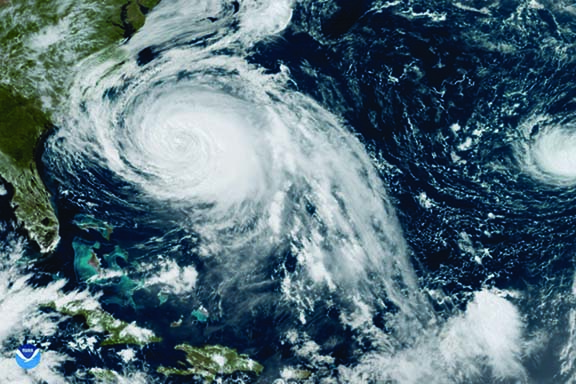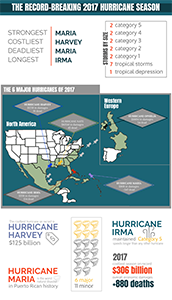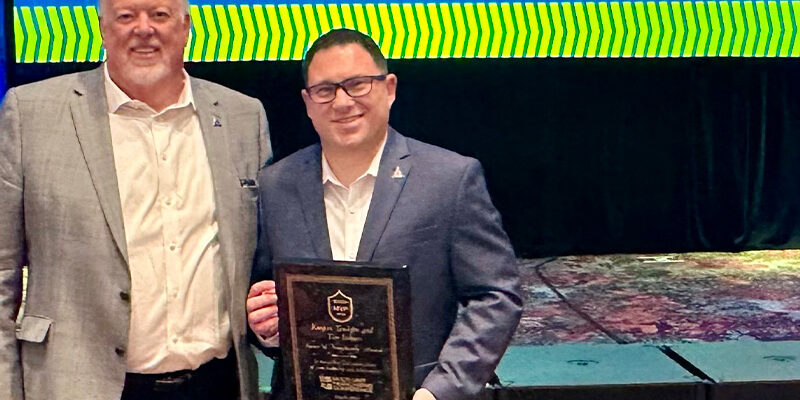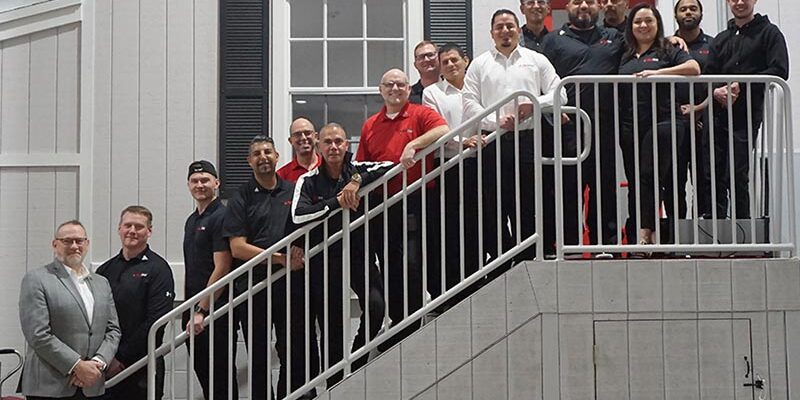Storm Chasing

By Jeff Cross
If it’s worth catching, it’s probably worth chasing.
That’s how most restoration contractors feel about storms — especially hurricanes — and the opportunities they bring ashore (pun intended) for companies engaged in disaster cleanup work.
The common catchphrase “storm chasing” has many implications for restorers. It can mean opportunity for a huge increase in revenue in a short period of time. It can also spell disaster for those who are unprepared for the unique challenges inherent with mobilizing in response to a climate disaster.
There were many lessons learned from the 2017 hurricane season. Thousands of restoration companies responded to the needs of those affected. Many of them profited and enjoyed a financial gain for their efforts. Others weren’t as fortunate, despite the best of intentions, perhaps only breaking even. Some were destroyed, financially speaking.
What happened in 2017
The National Centers for Environmental Information (NCEI) released information indicating that combining all of 2017’s climate disasters — including hurricanes, widespread flooding, fires, and more — resulted in a calendar year that was the costliest on record since the organization began assessing data in 1980.
According to the NCEI, the overall cost for 2017 climate disasters was tagged at $306.2 billion, while 2005, the year Katrina hit, held the previous record at $214 billion in losses. That’s a huge monetary disparity in damage to homes, businesses, properties, and — never to be forgotten or minimized — people’s lives.
When you add up all the years since data tracking began in 1980, losses hit an estimated $1.5 trillion. And 2017 accounts for more than 20 percent of that total.
Yes, 2017 landed into the record books with a solid thud and no doubt will stay at the top of the list of costliest years for storm damages — until the next one, of course. It is anyone’s guess as to when that will happen. But happen it will. That’s virtually a guarantee.
Are you ready for it?
What can happen in 2018
While an often-repeated joke includes the punchline of how meteorologists are often wrong regarding their forecasts and yet remain employed, we still give them our full attention, because we want to know.
If you research what several national meteorological services and scientific agencies are predicting for 2018, you will find their claims range from “above normal” to “active” to “busy” — among others. The bottom line is the consensus is this year could be a bad one for hurricanes, not to mention other climate disasters that can pop up across the country.
This means, if you are planning to be part of the brave crowd that chases storms, or if you live and work in what can become a hurricane-ravaged area, preparing now is key. Waiting until the storm is on the horizon and resources are quickly gobbled up by those who are ready is not going to bode well for you.
What you can do now
Cleanfax interviewed and gathered information from several sources in the restoration industry — experts and companies key to helping contractors succeed when engaged in large-scale disaster restoration efforts.
The following will get you started. Read on and see if jumping into storm chasing is for you.
Marketing your services
If you are traveling or a local company, you need to market to areas that are storm prone.
“You need to build relationships, and marketing is the best way to do this,” says Rick Daniel, a More Floods member and the owner of Roadrunner Restoration in Houston. “It costs time and money but will pay off in the end when a catastrophe strikes.”
As far as the type of marketing that works in these situations, according to Jathan Brensing, a 20-year restoration veteran and the member support director at More Floods, get ready to work. “Make phone calls and send out mass emails to your market area to adjusters, business owners, schools, engineers, property managers, hospitals, hotels, and others, letting them know you are available and ready to serve the community.” They will need you, and if they know about you, you will get work from your efforts.
Yet there will be challenges, as noted by Derek Niederquell, regional manager and brand manager for 1-800 WATER DAMAGE. “Although potential customers are in need, do not under-estimate their suspicions of out-of-town companies that are only there for a couple of weeks.”
Advanced storm chasing preparation
Storm chasing doesn’t mean you load up your equipment and get your crew ready when an event occurs. It means prepping in advance — most likely, several months in advance — like right now.
“We have created written load lists prior to the storms, so we don’t have to trust mental lists,” says Craig Kersemeier, president and general manager of K-tech Kleening Systems Inc. with headquarters in Weston, WI, and two additional offices in Rhinelander and Sturgeon Bay. His company has everything it needs well in advance including team members who are willing to travel and who are qualified to handle the challenges inherent to storm work.
Kersemeir also recommends making contact and connections in advance with other restoration companies in the target area so the mobilizing company has a destination upon arrival. “And commit early if you are going to do storm work,” he adds. “You can land some nice commercial work by being there first.”
Part of the preparation is realizing not everyone is going on the road. You still have a restoration company “back home” to run, after all.
That’s something Niederquell emphasizes. “Can you take care of business back home? What if the phone starts to ring once you cross over the state line?” he says. “Keeping personnel behind will ensure you don’t fail your clients that you have been marketing to all year long.”
And before committing to mobilizing for restoration work, Niederquell says, one of the most important tasks you need to do is look in the mirror and ask yourself if you are “in” or “all-in.” The answer should be a clear indication if this mobilization will be a success for you, for your company, and for those on your team who are committing to your company leaving their families behind.
“It takes a strong leader with a key sense of calling the right shots in these situations,” Niederquell explains. “Now that you are mobilized, who’s taking care of your business back home?”
And you don’t have to take on every job that comes your way, nor hit the road every time a storm hits outside your immediate demographic. “Know when to say ‘no’ to traveling for storm work,” Kersemeier advises. “It can put a strain on your regular customers and staff as well as your traveling crew.”
Clint Junell, co-creator of Job-Dox, a restoration project management software company, echoed those sentiments. “Chasing storms requires preparation up front and involves clearly defined expectations,” he says. “If you can’t afford the risk, then don’t chase the storm. There will be plenty of companies that close their doors” after engaging in storm chasing.
Heading out
This is where the rubber hits the road. Your company must be adept at mobilizing, staging, and delivery of restoration services, as well as being ready for sudden changes and unexpected twists and turns that accompany these restoration projects.
“Items such as gas can prove to be a hot commodity once you get into the thick of things,” Niederquell warns. “It’s hard to pivot or get to an appointment across town when you’re running on empty. And don’t forget to have lodging for everyone locked down before leaving your home office.”
Still, with a proper plan, a company can make it work. “Traveling can be profitable, if you do it correctly,” says Daniel. “You have to be ambitious and expect to spend a lot of money. Traveling, labor costs, food, hotels, and more will add up.”
And as for mobilizing, “Make sure your supplies are stocked. Order extra equipment ahead of time and find labor personnel, the manpower, before the storm hits,” advises Brensing. “Stock fuel, water, ready-to-eat meals, and coordinate sleeping arrangements with hotels, motels, and local churches. Be prepared to sleep in trucks, tents, campers, anywhere… and work extra-long hours. Stock trailers and trucks with a lot of dehumidifiers, air movers, desiccants, generators, and any other equipment you may need in bulk.”
Equipment can be the make-or-break issue in situations like this. “Have a contract or affiliate with a large loss company or rental company so you can get rental equipment. Be the one with the equipment. You don’t want to be looking for it once you get there,” Brensing adds.
Financial matters
At the end of the day, those involved in storm chasing must generate revenue and realize a profit. This means having a system in place to get paid in a timely and fair manner.
“If you are going to provide assistance to other companies,” Kersemeier says, “have your agreement up front on how each is going to get paid.”
In addition, remember that common practices involving money may not apply. “Cash is king in some storm areas that don’t have electricity. No ATMs. No credit cards,” Kersemeier warns. “And have a good relationship with your bank, as it can sometimes take a while to get completely paid.”
That’s something Junell sees frequently. “Billing is always an issue, and there will be outstanding invoices,” he says. For jobs in 2017, “We are still providing additional documentation and breakdown of information to adjusters and consultants. The carriers and consultants are still trying to figure out all the data they have in front of them.”
The learning curve
No matter how many storms you chase or how many jobs you land, you will find surprises along the way, and you will face unique challenges.
Be cautious while storm chasing. Be smart. “It’s not a ‘sexy’ job,” warns Daniel. “It takes a lot of hard work, there are a ton of illnesses circulating, and there are huge labor shortage issues. Plan to spend a lot of money if you want to make money, and the money from the large CAT jobs may not come in for months after you complete the job.”
You may have years of experience in the restoration industry, but that doesn’t mean you have the type of experience needed to chase storms. Have a willing-to-learn attitude. “The biggest thing is we continue to learn on every one of these events,” Kersemeier recalls.
And learn you will if you jump into storm chasing. If you do it, do your homework, make valuable contacts, prepare well in advance, and commit. The payoff may be worth it.
Jeff Cross is the executive editor of Cleanfax. He can be reached via email at [email protected].













